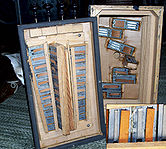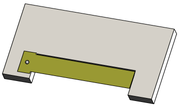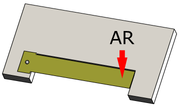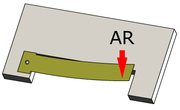
Free reed aerophone
Encyclopedia

A free reed aerophone is a musical instrument
Musical instrument
A musical instrument is a device created or adapted for the purpose of making musical sounds. In principle, any object that produces sound can serve as a musical instrument—it is through purpose that the object becomes a musical instrument. The history of musical instruments dates back to the...
where sound
Sound
Sound is a mechanical wave that is an oscillation of pressure transmitted through a solid, liquid, or gas, composed of frequencies within the range of hearing and of a level sufficiently strong to be heard, or the sensation stimulated in organs of hearing by such vibrations.-Propagation of...
is produced as air flows past a vibrating reed
Reed (instrument)
A reed is a thin strip of material which vibrates to produce a sound on a musical instrument. The reeds of most Woodwind instruments are made from Arundo donax or synthetic material; tuned reeds are made of metal or synthetics.-Single reeds:Single reeds are used on the mouthpieces of clarinets...
in a frame. Air pressure is typically generated by breath or with a bellows
Bellows
A bellows is a device for delivering pressurized air in a controlled quantity to a controlled location.Basically, a bellows is a deformable container which has an outlet nozzle. When the volume of the bellows is decreased, the air escapes through the outlet...
.
Operation
The following illustrations depict the type of reed typical of harmonicaHarmonica
The harmonica, also called harp, French harp, blues harp, and mouth organ, is a free reed wind instrument used primarily in blues and American folk music, jazz, country, and rock and roll. It is played by blowing air into it or drawing air out by placing lips over individual holes or multiple holes...
s, pitch pipes, accordion
Accordion
The accordion is a box-shaped musical instrument of the bellows-driven free-reed aerophone family, sometimes referred to as a squeezebox. A person who plays the accordion is called an accordionist....
s and reed organ
Reed organ
A reed organ, also called a parlor organ, pump organ, cabinet organ, cottage organ, is an organ that generates its sounds using free metal reeds...
s as it goes through a cycle of vibration. One side of the reed frame is omitted from the images for clarity; in reality, the frame completely encloses the reed. Airflow over one side of the reed creates an area of low pressure on that side (see the Bernoulli's principle
Bernoulli's principle
In fluid dynamics, Bernoulli's principle states that for an inviscid flow, an increase in the speed of the fluid occurs simultaneously with a decrease in pressure or a decrease in the fluid's potential energy...
article for details), causing the reed to flex towards the low-pressure side. The reed frame is constructed so that the flexing of the reed obstructs the airflow, which reduces or eliminates the low pressure area and allows the reed to flex back.
 |
A reed is fixed by one end in a close-fitting frame. The loose end has a slight rising bend. |
 |
Air depression is applied under the reed; the reed prevents air flow, except for a small, high-velocity Velocity In physics, velocity is speed in a given direction. Speed describes only how fast an object is moving, whereas velocity gives both the speed and direction of the object's motion. To have a constant velocity, an object must have a constant speed and motion in a constant direction. Constant ... flow at the tip. |
 |
The reed is sucked through the opening, allowing the air to pass. |
 |
The elasticity of the reed forces it back through the frame. |
Each time the reed passes through the frame, it interrupts air flow. These rapid, periodic interruptions of the air flow create the audible vibrations perceived by the listener.
In a free-reed instrument, it is the physical characteristics of the reed itself, such as mass, length, cross-sectional area, and stiffness, which primarily determine the pitch (frequency
Frequency
Frequency is the number of occurrences of a repeating event per unit time. It is also referred to as temporal frequency.The period is the duration of one cycle in a repeating event, so the period is the reciprocal of the frequency...
) of the musical note produced. Of secondary importance to the pitch are the physical dimensions of the chamber in which the reed is fitted, and of the air flow.
History
Various free reed instruments appear to have been invented since antiquity, but were unknown in the West until comparatively recently. Among the ancient instruments, the kheneKhene
The khene is a mouth organ of Lao origin whose pipes, which are usually made of bamboo, are connected with a small, hollowed-out hardwood reservoir into which air is blown, creating a sound similar to that of the violin...
of Laos
Laos
Laos Lao: ສາທາລະນະລັດ ປະຊາທິປະໄຕ ປະຊາຊົນລາວ Sathalanalat Paxathipatai Paxaxon Lao, officially the Lao People's Democratic Republic, is a landlocked country in Southeast Asia, bordered by Burma and China to the northwest, Vietnam to the east, Cambodia to the south and Thailand to the west...
, the shēng
Sheng (instrument)
The Chinese sheng is a mouth-blown free reed instrument consisting of vertical pipes.Traditionally, the sheng has been used as an accompaniment instrument for solo suona or dizi performances. It is one of the main instruments in kunqu and some other forms of Chinese opera...
of China
China
Chinese civilization may refer to:* China for more general discussion of the country.* Chinese culture* Greater China, the transnational community of ethnic Chinese.* History of China* Sinosphere, the area historically affected by Chinese culture...
and the shō of Japan
Japan
Japan is an island nation in East Asia. Located in the Pacific Ocean, it lies to the east of the Sea of Japan, China, North Korea, South Korea and Russia, stretching from the Sea of Okhotsk in the north to the East China Sea and Taiwan in the south...
have survived to modern times. It has been claimed that the shēng was brought to Saint Petersburg
Saint Petersburg
Saint Petersburg is a city and a federal subject of Russia located on the Neva River at the head of the Gulf of Finland on the Baltic Sea...
, Russia
Russia
Russia or , officially known as both Russia and the Russian Federation , is a country in northern Eurasia. It is a federal semi-presidential republic, comprising 83 federal subjects...
, and other towns of Europe near the end of the 18th century, inspiring a series of inventions in the early 19th century that were the foundation of the development of the modern free reeds. At Copenhagen one of these instruments with brass pipes and free reeds in-caved into the sides of this pips inspired the organ builder Mr. Kirsnick to fit similar reeds into portable organs. See Allgemeine musikalische Zeitung. 5. März. 1823. Nr. 10"1880 Kirsnick moved to Saint Petersburg
Saint Petersburg
Saint Petersburg is a city and a federal subject of Russia located on the Neva River at the head of the Gulf of Finland on the Baltic Sea...
improved this new organ pipes to adjustable pitch with a hook. Christian Gottlieb Kratzenstein
Christian Gottlieb Kratzenstein
Christian Gottlieb Kratzenstein was a German doctor, physicist and engineer.In 1769 Kratzenstein constructed resonant cavities which, when he excited them by a vibrating reed, produced the sounds of the five vowels: a, e, i, o, and u....
built also his speaking machine in Copenhagen and he was in contact with Mr. Kirsnick. Christian Gottlieb Kratzenstein
Christian Gottlieb Kratzenstein
Christian Gottlieb Kratzenstein was a German doctor, physicist and engineer.In 1769 Kratzenstein constructed resonant cavities which, when he excited them by a vibrating reed, produced the sounds of the five vowels: a, e, i, o, and u....
did get an award for this machine in Petersburg but he never moved to Petersburg. His Machine or a copy of this Machine came to Paris very shortly after 1880. A very prominent person in Europe Georg Joseph Vogler
Georg Joseph Vogler
Georg Joseph Vogler, also known as Abbé Vogler , was a German composer, organist, teacher and theorist.Vogler was born at Pleichach in Würzburg...
did put all his effort to get this new type of organ pipes in use in church organs so he started with changing organs in Rotterdam
Rotterdam
Rotterdam is the second-largest city in the Netherlands and one of the largest ports in the world. Starting as a dam on the Rotte river, Rotterdam has grown into a major international commercial centre...
(1790), London
London
London is the capital city of :England and the :United Kingdom, the largest metropolitan area in the United Kingdom, and the largest urban zone in the European Union by most measures. Located on the River Thames, London has been a major settlement for two millennia, its history going back to its...
(1790) He was in London 1890 and recorded this in his autobiography, but it is unclear whether this was after or before his visit to Warschau in the same year. It is also unclear if he did make changes to church organs there. His Orchestrion that he was carrying with him was not using free reeds at this time., Frankfurt
Frankfurt
Frankfurt am Main , commonly known simply as Frankfurt, is the largest city in the German state of Hesse and the fifth-largest city in Germany, with a 2010 population of 688,249. The urban area had an estimated population of 2,300,000 in 2010...
(1791), Stockholm
Stockholm
Stockholm is the capital and the largest city of Sweden and constitutes the most populated urban area in Scandinavia. Stockholm is the most populous city in Sweden, with a population of 851,155 in the municipality , 1.37 million in the urban area , and around 2.1 million in the metropolitan area...
(1791), Paris
Paris
Paris is the capital and largest city in France, situated on the river Seine, in northern France, at the heart of the Île-de-France region...
(1796), Berlin
Berlin
Berlin is the capital city of Germany and is one of the 16 states of Germany. With a population of 3.45 million people, Berlin is Germany's largest city. It is the second most populous city proper and the seventh most populous urban area in the European Union...
(1800), Prag (1802), Wien
Wien
Wien is the German language name for Vienna, the city and federal state in Austria.* Wien , in Vienna, Austria* Theater an der Wien, a theater in Vienna located at the former river WienWien may also refer to:...
(1804), Salzburg
Salzburg
-Population development:In 1935, the population significantly increased when Salzburg absorbed adjacent municipalities. After World War II, numerous refugees found a new home in the city. New residential space was created for American soldiers of the postwar Occupation, and could be used for...
München (1805), ... up to 30 documented rebuilds of organs with new free reed type organ pipes. He also held lessons on University's and did all to promote this new type of reeds, not only in German speaking regions of Europe. The actual work was done by different Organ builders, and very many People ware involved in this, so it is nearly impossible that any organ builder in Europe did not know about free reeds after 1800. In the two years from 1802 to 1804 in Vienna, he spent time with Johann Nepomuk Mälzel
Johann Nepomuk Mälzel
Johann Nepomuk Maelzel [or Mälzel] was an inventor, engineer, and showman, best known for manufacturing a metronome and several music automatons, and displaying a fraudulent chess machine.-Life and work:...
and Mälzel did change the type of reeds used in his Panharmonicon
Panharmonicon
The Panharmonicon was a musical instrument invented in 1805 by Johann Nepomuk Mälzel, a contemporary and friend of Beethoven. Beethoven apparently composed his piece "Wellington's Victory" to be played on this behemoth mechanical orchestral organ to commemorate Arthur Wellesley's victory over the...
to free reed pipes. Vogler, Maelzel and Friedrich Kaufmann were then at the same time in Paris in the Year of 1807. From there Mälzel did go to Regensburg and Vienna where he constructed an new Panharmonicon and the mechaischer Trompeter, after that he did go on tour again to Paris, London and other places, maybe he went for the first time to Boston and New York as well, but up to now we don't know of any notice in a newspaper about it. Friedrich Kaufmann a clock maker went back home to Dresden and copped Mälzel's machines. The 'mechaischer Trompeter' still can be seen in a museum in Munich.
First use in America
In USA Organ builder William M. Goodrich is often claimed to have invented the free reed. This is not surprising, as he tells that he worked in the years of 1810 to 1812 with Johann Nepomuk MälzelJohann Nepomuk Mälzel
Johann Nepomuk Maelzel [or Mälzel] was an inventor, engineer, and showman, best known for manufacturing a metronome and several music automatons, and displaying a fraudulent chess machine.-Life and work:...
's Pan Harmonicon that was sent to Boston and then exhibited in several towns. Märzel had a very good relationship to Vogler while in Europe so his Pan Harmonicon used free reeds. It is not know with certainty whether Mälzel was personally in America around 1811. What is clear is that he arrived New York on February 7th, 1826, which might have been either his first or his second visit to the New World. He also visited Boston around this time.
1823 Pan Harmonicun copped.
There is a Story that in the Year of 1821 James H. Bazin did repair a free reed Pipe and used this type of reeds for constructing, in 1836, the "lap organ".
From 1833 Prescott did build similar Instruments.
Melodeons in 1840
By 1840 there were 40 melodeonMelodeon (organ)
A melodeon is a type of 19th century reed organ with a foot-operated vacuum bellows, and a piano keyboard. It differs from the related harmonium, which uses a pressure bellows. Melodeons were manufactured in the United States sometime after 1812 until the Civil War era...
builders in America.
Europe
Cyrill Demian's (see below) patent of 1829 however states that the reeds in his instrument "were known for more than 200 years as Regale, Zungen, Schnarrwerk, in organs." Of course he compares the reeds used by him with beating reeds.Some notable free reed instruments:
- The Chinese hulusiHulusiThe hulusi or cucurbit flute is a free reed wind instrument from China. It is held vertically and has three bamboo pipes which pass through a gourd wind chest; the center pipe has finger holes and the outer two are typically drone pipes...
and bawuBawuThe bawu is a Chinese wind instrument. Although shaped like a flute, it is actually a free reed instrument, with a single metal reed. It is played in a transverse manner... - Querhammerflügel with Aoline, circa 1810, made by Johann Kasper Schlimbach at Königshofen Bayern, using steel reeds and frames made in one part.
- The hand-aeoline, by Christian Buschmann, 1822.There is no evidence that this statement, still listed in many encyclopedias, is reliable; a grandson of Buschmann made this claim in 1910, in his magazine article Hundert Jahre des Harmoniumbaus und andere Zungeninstrumente 1810 - 1910, in the magazine Zeitschrift für Instrumentenbau http://daten.digitale-sammlungen.de/~db/bsb00004256/images/index.html?seite=1060
- The accordionAccordionThe accordion is a box-shaped musical instrument of the bellows-driven free-reed aerophone family, sometimes referred to as a squeezebox. A person who plays the accordion is called an accordionist....
, patented in 1829 by Cyrill Demian. - The concertinaConcertinaA concertina is a free-reed musical instrument, like the various accordions and the harmonica. It has a bellows and buttons typically on both ends of it. When pressed, the buttons travel in the same direction as the bellows, unlike accordion buttons which travel perpendicularly to it...
, patented in two forms (perhaps independently):- Sir Charles Wheatstone, 1844.
- Carl Friedrich Uhlig, 1834.
Other examples
- The harmonicaHarmonicaThe harmonica, also called harp, French harp, blues harp, and mouth organ, is a free reed wind instrument used primarily in blues and American folk music, jazz, country, and rock and roll. It is played by blowing air into it or drawing air out by placing lips over individual holes or multiple holes...
. - The harmoniumHarmoniumA harmonium is a free-standing keyboard instrument similar to a reed organ. Sound is produced by air being blown through sets of free reeds, resulting in a sound similar to that of an accordion...
. - The melodicaMelodicaThe melodica, also known as the "blow-organ" or "key-flute", is a free-reed instrument similar to the melodeon and harmonica. It has a musical keyboard on top, and is played by blowing air through a mouthpiece that fits into a hole in the side of the instrument. Pressing a key opens a hole,...
. - The bandoneónBandoneónThe bandoneón is a type of concertina particularly popular in Argentina and Uruguay. It plays an essential role in the orquesta típica, the tango orchestra...
. - The hulusiHulusiThe hulusi or cucurbit flute is a free reed wind instrument from China. It is held vertically and has three bamboo pipes which pass through a gourd wind chest; the center pipe has finger holes and the outer two are typically drone pipes...
.
Related instruments
In the related woodwind instruments, a vibrating reed is used to set a column of air in vibration within the instrument. In such instruments, the pitch is primarily determined by the effective length of that column of air. Although the Chinese shengSheng (instrument)
The Chinese sheng is a mouth-blown free reed instrument consisting of vertical pipes.Traditionally, the sheng has been used as an accompaniment instrument for solo suona or dizi performances. It is one of the main instruments in kunqu and some other forms of Chinese opera...
, Japanese sho and Laotian khene
Khene
The khene is a mouth organ of Lao origin whose pipes, which are usually made of bamboo, are connected with a small, hollowed-out hardwood reservoir into which air is blown, creating a sound similar to that of the violin...
have pipes, the pipes do not determine the pitch. In these instruments, the pipes serve as resonating chambers.

